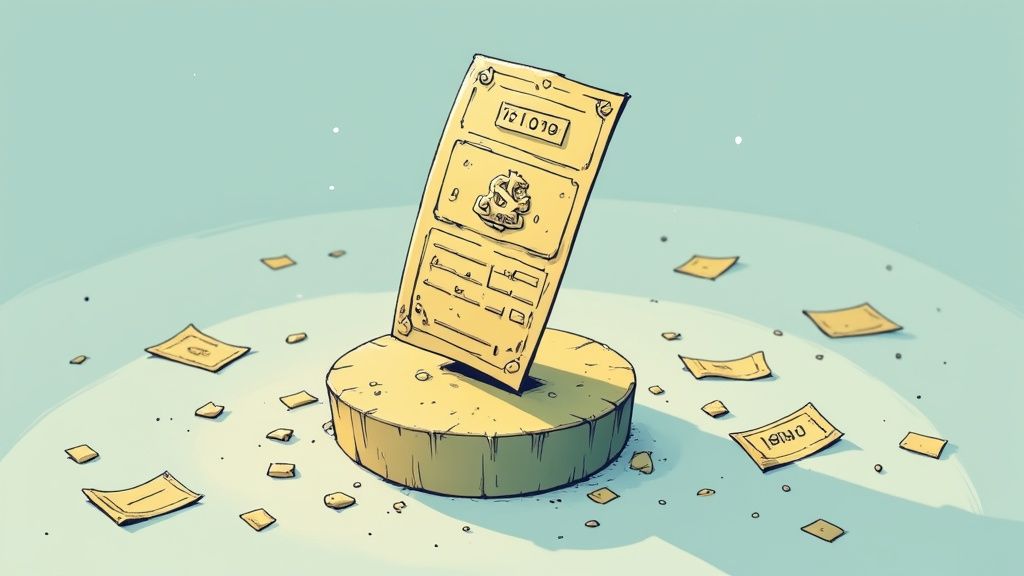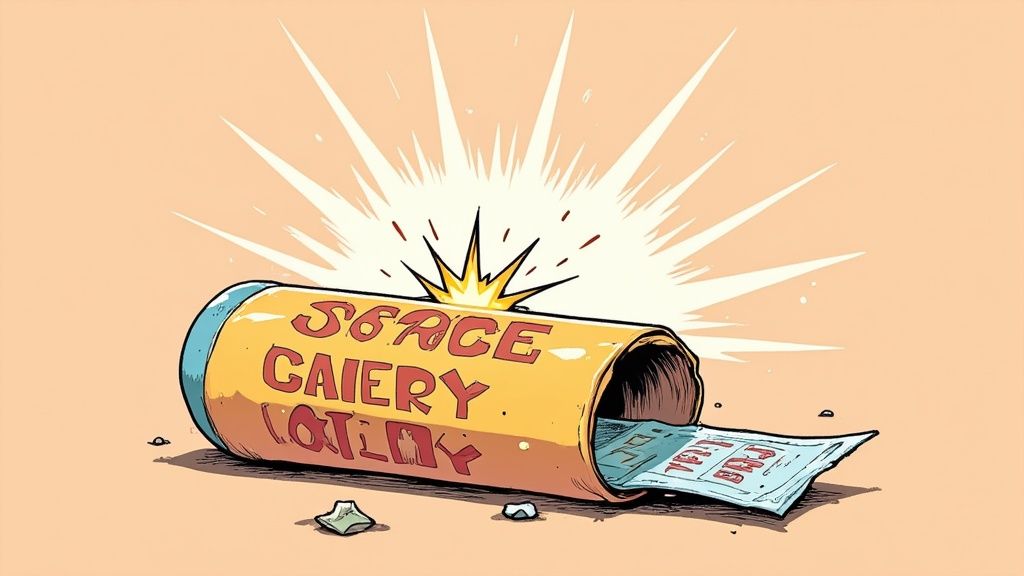Ready to Win Big? Try These Instant Wins Lotto Strategies
Want to increase your odds with Instant Wins Lotto? This listicle reveals six proven strategies to boost your chances of winning. Learn how to manage your budget effectively, select the right tickets, and even where to buy them for a potential advantage. Whether you’re after small, consistent wins or aiming for the jackpot, these tips will help you play smarter. We’ll cover budget management, ticket denominations, new game launches, retailer selection, remaining prize analysis, and sequential purchasing to improve your Instant Wins Lotto game. Let’s dive in.
1. Budget Management Strategy
One of the most crucial aspects of playing instant win lotto games, especially in the UK, is implementing a robust budget management strategy. This disciplined approach involves setting strict spending limits and adhering to a predetermined budget, ensuring that lottery play remains a form of entertainment rather than a financial investment. It’s about maximizing enjoyment while minimizing the risk of financial hardship, promoting responsible play, and preventing the potential for problem gambling. This strategy emphasizes the importance of only spending what you can comfortably afford to lose.

This strategy deserves a top spot on any “instant wins lotto” list because it directly addresses the potential financial pitfalls associated with gambling. It provides a framework for responsible play, ensuring that the excitement of the lottery doesn’t overshadow sound financial decision-making. By implementing a budget management strategy, players can enjoy the thrill of instant win games without jeopardizing their financial well-being.
The core of a budget management strategy revolves around several key features: establishing fixed spending limits, whether weekly or monthly; allocating a separate “entertainment budget” specifically for lottery play; meticulously tracking all lottery expenditures; strictly prohibiting the use of borrowing or credit for lottery purchases; and conducting regular budget reviews and adjustments as needed. For example, you might decide to allocate £20 a month for instant win lotto tickets. This becomes your dedicated lottery fund, and once it’s depleted, that’s it for the month. Using a lottery budgeting app or even a simple spreadsheet can help you track your spending and stay within your limits. You could also establish a family lottery spending agreement, ensuring everyone is on the same page about responsible play.
Implementing a budget management strategy offers numerous advantages. It acts as a safeguard against financial hardship and the development of gambling addiction. It allows for sustainable long-term play, ensuring that the enjoyment of instant win games doesn’t become a short-lived, financially draining experience. By reducing the emotional stress associated with losses, it enables more rational decision-making, reinforcing the concept of lottery play as a form of entertainment rather than a get-rich-quick scheme.
However, like any strategy, it also has its limitations. It limits the potential for larger ticket purchases, which some players might find restrictive. It requires a significant degree of self-discipline to adhere to the budget, especially when faced with tempting jackpots or a string of losses. And, importantly, it doesn’t increase the actual odds of winning.
Using cash only for lottery purchases is a practical tip to enhance budget visibility. Setting up automatic transfers to a separate lottery fund can automate the process and remove the temptation to overspend. Regularly reviewing and adjusting the budget, perhaps quarterly, allows the strategy to adapt to changing financial circumstances. Remember to never chase losses by exceeding budget limits, and always consider lottery play as the cost of entertainment, not an investment.
Learn more about Budget Management Strategy for valuable insights into financial planning, especially relevant for those fortunate enough to win big. This article provides essential guidance on navigating the complexities of sudden wealth.
This budget-conscious approach is often championed by financial advisors, responsible gambling advocates, and even lottery commissions themselves, all promoting responsible play. Personal finance experts, like Dave Ramsey, also emphasize the importance of budgeting and mindful spending, which naturally extends to entertainment expenses like lottery tickets. By adopting a budget management strategy, players in the UK can enjoy the thrill of instant win lotto games responsibly and sustainably.
2. Higher Denomination Ticket Strategy
When playing the instant wins lotto, most people gravitate towards purchasing a larger quantity of cheaper tickets, hoping to increase their odds by sheer volume. However, the higher denomination ticket strategy flips this approach on its head. It suggests that focusing on fewer, more expensive tickets (£10, £20, £30, etc.) can actually offer a more strategic path to winning, particularly for those aiming for more substantial prizes. This strategy hinges on the premise that higher-priced instant wins often come with improved overall odds and significantly larger potential payouts, though this does come with a heightened risk per purchase.

This strategy deserves its place on the list because it offers a different perspective on maximizing your chances in the instant wins lotto. While buying many cheaper tickets might feel like you’re casting a wider net, the higher denomination approach is about focusing your resources on games with potentially better returns and bigger rewards. This strategy isn’t about just spending more; it’s about spending smarter. It involves understanding the nuances of different ticket tiers and leveraging the improved odds and prize structures that more expensive tickets often offer.
The core features of this strategy revolve around targeting instant win tickets priced at £10 or more. These tickets often boast better overall odds ratios compared to their cheaper counterparts. For example, a £20 ticket might offer a 1 in 3 chance of winning any prize, while a £1 ticket might only offer a 1 in 4 chance. Furthermore, the maximum prize amounts for higher denomination tickets are generally substantially higher, sometimes reaching into the millions. This strategy inherently means purchasing fewer total tickets, shifting the focus from volume to strategic selection. Higher denomination tickets also tend to have more complex game mechanics and bonus features, adding another layer of engagement to the gameplay.
The benefits of this strategy include potentially better overall return-to-player percentages. This means that, over time, you might see a higher percentage of your money returned as winnings compared to playing cheaper tickets. The allure of larger potential winnings is another significant draw, offering the chance to snag a life-changing sum. The more engaging gameplay features found on these tickets can also make the experience more enjoyable, even if you don’t win the top prize. Finally, by playing fewer tickets, you reduce the frequency of small, insignificant wins and losses, leading to a higher probability of experiencing more meaningful wins.
However, it’s crucial to acknowledge the inherent risks. The higher cost per ticket undeniably increases the financial risk. With the same budget, you’ll have fewer chances to play compared to buying cheaper tickets. This also means that when a higher denomination ticket doesn’t win, the loss is more significant. This can potentially encourage overspending if not managed carefully.
To illustrate, consider a scenario where you have £20 to spend. You could buy twenty £1 tickets with a 1 in 4 chance of winning, or two £10 tickets with a hypothetical 1 in 3.5 chance. While the cheaper tickets give you more chances to play, the £10 tickets offer better odds and potentially larger prizes. Another example would be focusing on £30 premium games with million-pound jackpots. Or, for a more balanced approach, selecting mid-tier £10 tickets offers a compromise between risk and reward.
To successfully implement this strategy, thorough research is key. Before purchasing, carefully examine the odds and prize structures of different ticket denominations. Learn more about Higher Denomination Ticket Strategy to understand the nuances of this approach. Starting with mid-tier denominations like £10 tickets is a good way to test the strategy without incurring excessive risk. Crucially, only purchase higher denomination tickets within a pre-defined budget. Look for newer games that might have more unclaimed prizes, potentially increasing your odds. Finally, avoid the highest denomination tickets unless you can genuinely afford the potential loss. This measured approach ensures that you’re enjoying the potential benefits of the higher denomination ticket strategy while mitigating the inherent financial risks.
3. New Game Launch Strategy
One of the most compelling strategies for maximizing your chances in instant wins lotto is the New Game Launch Strategy. This approach centers around purchasing tickets from newly released instant lottery games, capitalizing on the period when the full complement of prizes, including the top jackpots, are still in circulation. The underlying principle is simple: as a game progresses, top prizes are claimed, reducing the overall odds of winning for remaining players. By focusing on new games, you’re essentially playing against a statistically “fresher” pool of tickets, giving you the best possible chance of snagging a significant prize.

This strategy deserves a place on this list because it directly addresses a key factor influencing instant win odds – the availability of top prizes. Instead of chasing dwindling odds in older games, it proactively positions you for the best possible statistical advantage from the outset. The key features of this approach include focusing on games launched within the last 30-60 days, ensuring full prize pool availability, accessing fresh ticket inventory, taking advantage of maximum promotional support often associated with new launches, and ultimately, enjoying optimal statistical odds.
The advantages are numerous. First and foremost, all top prizes are still up for grabs, including the often life-changing jackpots. You’re playing with the best possible statistical odds the game will ever offer. The ticket stock is fresh, ensuring proper distribution of winning tickets across the retail network. New game launches are often accompanied by promotional bonuses, offering added value and increasing your potential returns. Finally, you’ll find the maximum variety of winning tickets in circulation during the initial phase of a new game.
However, like any strategy, the New Game Launch approach has its drawbacks. It requires constant monitoring of lottery releases in the UK, which can be time-consuming. The selection of eligible games at any given time is limited to recent launches. You might miss out on proven successful games that have established a track record of paying out. And lastly, new games inherently carry a degree of uncertainty; their appeal and player reception remain untested until they’ve been in the market for a while.
Consider these examples of successful implementation: A player diligently monitors the National Lottery website and discovers a new scratchcard game with a substantial top prize. They purchase a handful of tickets on launch day and win a significant amount. Another player focuses on holiday-themed instant wins when they first appear, capitalizing on the increased promotional activity and player excitement surrounding these special releases.
To implement this strategy effectively, consider these actionable tips: Subscribe to the National Lottery newsletter and other relevant lottery information sources for launch notifications. Develop relationships with local retailers and inquire about their typical new game arrival schedules. Research the track record of similar game formats to gauge potential success. Crucially, buy early in a new game’s lifecycle to maximize your odds, but always stay within your pre-established budget. Prefer retailers that frequently order fresh inventory, minimizing the risk of purchasing tickets from stale batches.
This New Game Launch Strategy has been popularized within lottery enthusiast communities, often discussed in online lottery strategy forums. State lottery marketing departments themselves indirectly promote this approach by highlighting the excitement and potential of new game launches. By understanding and applying this strategy, you can gain a significant edge in the world of instant wins lotto and potentially boost your chances of striking it lucky.
4. Retailer Selection Strategy
The Retailer Selection Strategy for instant wins lotto focuses on choosing where you buy your scratchcards as much as which scratchcards you buy. It’s based on the idea that not all lottery ticket retailers are created equal. Some may have a higher turnover of tickets, leading to “fresher” batches with potentially better odds, while others might simply be luckier based on their sales history. This strategy involves analysing factors like ticket sales volume, recent winner history, and how retailers manage their inventory to potentially improve your chances of winning. This approach leans into the anecdotal, relying on observed patterns and local knowledge, rather than hard statistical evidence.

This strategy deserves a spot on the list because, while not scientifically proven, it offers a proactive approach to playing instant wins. It encourages players to engage with the process beyond simply picking a card at random. For those who enjoy a bit of detective work and local exploration, it adds an extra layer of fun to the lottery experience. The Retailer Selection Strategy involves several key features: focusing on high-volume retailers like busy petrol stations or supermarkets, prioritising locations with publicly displayed recent winners, paying attention to how quickly tickets sell at a particular location (inventory turnover), and even considering the geographic distribution of winning retailers. Some proponents even analyse retailer winner displays, looking for patterns or clusters of wins.
Let’s explore a hypothetical scenario. Imagine two retailers in your town: a quiet corner shop and a bustling supermarket. The supermarket, with its higher foot traffic, likely sells more lottery tickets. Proponents of this strategy suggest that higher sales volume could mean fresher batches of tickets arriving more frequently, theoretically increasing your chances of encountering a winning ticket. Further, large retailers often receive a wider distribution of prize values within their ticket allocations.
Actionable Tips for Implementing the Retailer Selection Strategy:
- Engage with Retail Staff: Don’t be afraid to ask shop assistants about recent big winners or when they expect new ticket deliveries. Building rapport with retail staff can be invaluable for gathering “insider” information.
- Observe Ticket Condition and Storage: Look at how tickets are stored. Are they kept in a tidy, organised manner, or do they look old, faded, or damaged? Avoid tickets that appear worn, bent, or have damaged scratch-off surfaces.
- Monitor Turnover: Take note of how quickly the scratchcard displays are replenished. A high turnover rate may indicate fresher stock.
- Consider Timing: Try to time your purchases around delivery schedules. This might involve visiting the retailer shortly after they’ve received a new shipment of tickets.
- Track Your Own Data: Keep a record of where you buy your tickets and any wins, however small. This personal data can help you identify any trends or patterns associated with specific retailers.
- Research Winner Information: Some UK National Lottery retailers display information about recent winners. Take note of these locations and consider incorporating them into your strategy.
Pros of the Retailer Selection Strategy:
- Fresher Ticket Batches: Higher turnover potentially means access to more recently printed tickets.
- Improved Prize Distribution: High-volume retailers might receive a broader range of prize values.
- Psychological Advantage: Buying from a “lucky” retailer can boost confidence and add to the enjoyment.
- Local Knowledge: Building relationships with retailers can offer valuable insights into winning patterns.
Cons of the Retailer Selection Strategy:
- Lack of Scientific Evidence: There’s no concrete proof that this method increases winning odds.
- Inconvenience: It might require travelling further to specific retailers.
- Coincidence vs. Causation: A retailer’s success might be purely coincidental.
- Limited Choice: Restricts convenience of purchase locations.
The Retailer Selection Strategy, while lacking scientific backing, provides an engaging and proactive way to approach instant win lotteries. Popularised through local lottery player communities, retail representatives, and anecdotal stories from winners, this strategy adds an extra dimension to the game for those who enjoy a bit of local investigation and believe in the power of lucky locations. While success is not guaranteed, it can certainly make the lottery experience more interactive and fun. Remember, lottery games are ultimately games of chance, and responsible play should always be a priority.
5. Remaining Prize Analysis Strategy
For the data-driven instant wins lotto enthusiast, the Remaining Prize Analysis Strategy offers a methodical approach to enhance your chances of winning. This strategy leverages publicly available information about remaining prizes in active games to guide your purchasing decisions. Instead of relying on luck alone, you’re using concrete data to tilt the odds, however slightly, in your favour. This makes it a valuable tool for anyone serious about maximising their returns in the instant wins lotto arena.
The core principle of this strategy revolves around identifying games with the most favourable prize-to-ticket ratios. By regularly reviewing official lottery reports, you can pinpoint games where a significant number of prizes, especially top-tier prizes, remain unclaimed. This information allows you to focus your efforts on games with a higher probability of a return, potentially including a substantial win.
Implementing this strategy involves a few key steps. First, locate the official prize reports for the instant wins lotto games you’re interested in. These are usually available on the respective lottery operator’s website, such as the National Lottery website for UK players. Next, calculate the remaining prize ratios. This involves dividing the total value of unclaimed prizes by the estimated number of tickets still in circulation. This calculation gives you a clear picture of the potential return on investment for each game. Finally, focus on games with a healthy number of unclaimed top prizes. While smaller prizes contribute to the overall value, the top prizes significantly impact your potential winnings.
For example, imagine two instant wins lotto games: Game A and Game B. Both initially offered a £1 million top prize. Game A has one remaining £1 million prize and an estimated 500,000 tickets still in circulation, while Game B has no remaining top prizes and an estimated 1 million tickets remaining. Applying the Remaining Prize Analysis Strategy would lead you to choose Game A, as it offers a higher probability of winning the top prize.
Tracking prize claim patterns over time also provides valuable insights. By observing how quickly prizes are claimed, you can estimate the remaining ticket pool more accurately and refine your calculations. Creating spreadsheets to track these patterns and calculate effective odds based on remaining prizes and estimated tickets sold is a common practice amongst those who employ this strategy. You might even discover patterns related to specific days or times when fewer tickets are purchased, leading to subtly improved odds.
Learn more about Remaining Prize Analysis Strategy
The benefits of this strategy are clear. It’s grounded in actual data rather than speculation, helping you avoid games where the top prizes have already been claimed. It enables a mathematical comparison between different games, allowing you to make informed decisions about where to allocate your resources. And importantly, the information required is publicly available.
However, the Remaining Prize Analysis Strategy isn’t without its drawbacks. It requires consistent research and calculations, demanding time and effort. The information you find may be slightly delayed or outdated, impacting the accuracy of your analysis. Furthermore, while this strategy improves your overall odds, it doesn’t guarantee individual ticket success – remember, the lottery remains a game of chance. Finally, this approach might limit your game variety and spontaneity, as you focus primarily on games meeting specific criteria.
Here are some tips for effectively utilizing the Remaining Prize Analysis Strategy:
- Check prize reports weekly: Stay updated on the latest prize information for the most accurate analysis.
- Focus on games with at least 50% of top prizes remaining: This threshold generally indicates a favourable prize-to-ticket ratio.
- Calculate effective odds: Factor in the remaining prizes and the estimated number of tickets left unsold to determine the true odds.
- Avoid end-of-life games: Games nearing their end date typically have fewer prizes left, diminishing your winning potential.
- Cross-reference data sources: If multiple data sources are available, compare them to ensure accuracy and gain a more comprehensive understanding.
The Remaining Prize Analysis Strategy, popularized by data-driven lottery analysts and mathematical gambling strategists, owes its existence partly to state lottery transparency initiatives. By making prize data public, these initiatives have empowered players to make more informed choices. While this method doesn’t eliminate the element of chance inherent in the instant wins lotto, it provides a structured approach to improve your odds. For the analytical player seeking a data-driven edge in the world of instant wins, this strategy provides a valuable framework for increasing the likelihood of a successful outcome.
6. Sequential Purchase Strategy
The Sequential Purchase Strategy is a popular approach to playing instant win lotto games, particularly scratch-off tickets. It hinges on the idea that winning tickets aren’t distributed completely randomly within a roll or batch, but instead might follow discernible patterns. While there’s no scientific basis for this theory, some players believe that wins tend to cluster together or that certain positions within a roll are more likely to produce winners. This strategy allows players to test these theories and potentially capitalize on any perceived patterns. This makes it a fascinating approach for those interested in exploring the mechanics of instant win lotto games and trying to gain an edge, even if a purely statistical one isn’t guaranteed.
This strategy involves buying multiple consecutively numbered instant win lotto tickets from the same roll or batch. For example, instead of buying single tickets from various rolls, you might buy five, ten, or even more tickets in a row. Some players even go so far as to purchase entire ticket books when permitted by the retailer and the rules of the specific instant win lotto game. The logic behind this strategy is twofold. First, if wins do indeed cluster, purchasing consecutive tickets increases the chance of hitting multiple winners in a single purchase. Second, it allows for a more focused analysis of potential patterns in the distribution of winning tickets within a roll. By focusing on a smaller segment of the overall game, players can track winning numbers, ticket positions, and other factors more effectively.
While anecdotal evidence of success with this strategy exists within the lottery community, it’s crucial to remember that no scientific studies confirm the existence of predictable patterns in instant win lotto games. Stories of players winning multiple times in a row using sequential purchases are often shared, fuelling the popularity of this approach. For example, imagine someone buying a book of 20 consecutive tickets and finding three winning tickets within that sequence. This kind of experience can reinforce the belief in patterns, even if it’s statistically possible within a random distribution. Another example might be a player consistently noticing wins on tickets ending in specific digits within a sequential purchase, leading them to believe those numbers hold a key to winning. These examples, while compelling, are often attributed to chance rather than a proven system.
If you’re considering the Sequential Purchase Strategy, it’s vital to approach it with caution and a healthy dose of scepticism. Here are some actionable tips to keep in mind:
- Start Small: Begin by purchasing smaller sequences of consecutive instant win lotto tickets (e.g., 5-10 tickets) to test the waters and familiarise yourself with the process of tracking results. This will help you manage your budget and avoid overspending while exploring the strategy.
- Meticulous Tracking: Maintain a detailed record of your purchases, including the roll number, ticket numbers, and the outcome of each ticket. This data will allow you to analyse potential patterns over time.
- Budget Wisely: Only use money allocated within your entertainment budget. Treat instant win lotto as a form of entertainment and avoid chasing losses or exceeding your predetermined spending limits.
- Game Research: Focus on instant win lotto games you’ve researched thoroughly. Understanding the odds, prize structure, and overall mechanics of a specific game can inform your strategy and help you make more informed decisions.
- Accept Randomness: Be prepared for the possibility that patterns don’t exist. The inherent randomness of lottery games means that even with a sequential approach, there’s no guarantee of consistent wins.
The Sequential Purchase Strategy is popularised by professional lottery players, strategy theorists, and even some gambling mathematics researchers who explore the possibility of exploitable biases in lottery games. While their interest adds an element of intrigue to this approach, remember that even experts haven’t definitively proven the existence of predictable patterns.
This strategy deserves a place on this list because it offers a structured approach to playing instant win lotto, allowing players to engage with the game in a more analytical way. While the effectiveness of identifying patterns remains unproven, the strategy provides a framework for testing theories, managing purchases, and potentially increasing the excitement of playing. It’s important to remember that the fundamental nature of instant win lotto relies on chance, and no strategy can guarantee consistent wins.
Instant Win Lotto Strategies Comparison
| Strategy | 🔄 Implementation Complexity | 📊 Expected Outcomes | ⚡ Resource Requirements | 💡 Ideal Use Cases | ⭐ Key Advantages |
|---|---|---|---|---|---|
| Budget Management Strategy | Low – Simple budgeting & tracking | Steady, sustainable play; no impact on odds | Low – Time for tracking, self-discipline | Responsible players prioritizing control | Prevents financial hardship; promotes discipline |
| Higher Denomination Ticket | Medium – Requires odds research | Potentially higher returns with bigger wins | Medium – Higher ticket cost per unit | Players seeking bigger payouts | Better odds and payouts; engaging gameplay |
| New Game Launch Strategy | Medium – Needs constant monitoring | Better odds initially due to full prize pools | Medium – Time to track releases | Early adopters wanting fresh opportunities | Access to unclaimed top prizes; promotional bonuses |
| Retailer Selection Strategy | Medium – Requires site visits and data | Possibly improved chances via fresh tickets | Medium – Travel and observation effort | Players with local access and patience | Higher ticket turnover; insider access |
| Remaining Prize Analysis | High – Involves detailed data review | More informed purchases; optimized odds timing | High – Research, calculations | Data-driven players focused on stats | Uses actual data; identifies best games |
| Sequential Purchase Strategy | High – Bulk purchases and tracking | Potential clustering benefits but unproven | High – Larger upfront investment | Players testing ticket distribution theories | Possible pattern exploitation; deep game insight |
Maximize Your Instant Wins Lotto Success
Playing the instant wins lotto can be an exciting experience, and while luck plays a major role, employing smart strategies can improve your overall gameplay. We’ve covered several key approaches in this article, from managing your budget effectively and exploring higher denomination tickets to understanding new game launch advantages and strategically selecting your retailer. Remember the power of remaining prize analysis and consider the benefits of the sequential purchase strategy. Mastering these concepts empowers you to make informed decisions, potentially increasing your chances of scoring those instant wins lotto prizes. This translates to not only the thrill of the win, but also the potential for financial gains, adding a new dimension to your entertainment budget.
Ultimately, playing the instant wins lotto should be enjoyable. By incorporating these strategies, you’re not just scratching off tickets – you’re playing smarter, adding a layer of strategy to the fun. Want to explore another exciting avenue for potential wins? Check out Lucky Turbo Competitions for a wide range of prize draws and competitions, offering another way to test your luck and potentially win big. Visit Lucky Turbo Competitions today and see what exciting prizes await!
